Happy Tuesday and welcome to my first ever analog tutorial!
Writing yesterday's blog post I mentioned that I was surprised that I couldn't find this method elsewhere on the internet, and thus came my desire to write my own photo tutorial.
This method is super easy, super fast, and pretty inexpensive. No special solvents or tools required. You'll be carving and printing in no time at all. And if there is another similar post out there somewhere, all the better - more tips and tricks from different sources to go around. Anyhow, enough chatter. Let's get to the photo demo/tutorial that I promised.
*Before I begin, I'll have to say that I did not discover this transfer technique on my own. I learned this technique at university, in a class taught by Mr. Adam Rogers. I'm sorry if this was supposed to be a secret, though I don't think that's the case.
Finally. I present to you: "Iron on the Image - the Quick, Easy, and Accurate Way of Transferring a Picture to Linoleum Blocks"
(A long title, alas)
MATERIALS:
1. Your choice of a linocut block. (I worked with the medium-softness, thin, charcoal-grey coloured kind)
2. A photocopy or printout of your image using a xerox machine or laser printer. THIS IS IMPORTANT. Otherwise the transfer won't work, or won't work as well. (Also, you may want to photocopy an extra copy, just in case you make a mistake during the transfer and want to restart)
3. Clothing Iron
4. Pencil
*Q-tip, paper towel, or cotton round + nail polish remover (In case of accidents)
PROCEDURE:
Step 1: Select the image you wish to turn into a linocut print and turn it into a black and white image, if you haven't already. Since we'll be transferring this image on to a piece of linoleum that might not be white, we want as much contrast as possible, so we'll be able to see what we're cutting out later.
Step 2: Print out or photocopy your image either by printing with a laser printer or getting a good old photocopy from an office, or an office supply store. This is very important as images printed with inkjet printers don't tend to transfer well using this method. The reason being is that with the laser printer/xerox - more of the ink sits on top of the paper and therefore this ink can be easily released on to a new surface by being reheated and pressed, as we'll be doing later.
Step 3. Trim your sheet of paper to be slightly larger than the linocut block, so it will undoubtedly cover it completely. The reason why the paper has to cover the linoleum completely is because the heat from the iron can melt the linoleum and then the linoleum surface is all weird, it smells nasty, your iron is all dirty, and all that other annoying stuff that that delays your artistic process. IF you're working with a linoleum piece larger than the paper you printed on, you can always find a larger piece of paper and paste the paper with your image on to that. I also recommend printing a border (the size of your lino block) around your image to make registration very straightforward.
As you can see, I printed my images with such a border, making placement of the lino block on to the paper later super easy.
Step 4: Go to a light table or a brightly lit window and with a pencil, mark off the corners of the border on the reverse side of the paper.
I like to do this so that when I'm ironing I know where the lino block and image are beneath the paper.
Step 5: Set up your ironing board or table, plug in your clothes iron and let it heat up to a low temperature setting. Mine was on "1- Acrylic". (*Of course, irons many vary in their temperature settings, so it is best to do a couple of small tests before working with the final lino block) We don't want it any hotter than that because I've found that hotter temperatures melt the ink too much and it become a bit blurry when being transferred. While the iron is taking a moment to heat up, we're going to line up our picture and linoleum piece.
Put your paper down on your ironing station - image side up and then place the lino block on top, lining it up with the handy border we printed. Then, holding the two pieces together carefully, we're going to flip them so that the lino block is at the bottom.
Double check that the border and the linocut block are still lining up. And if your iron has heated up, then we are ready to proceed to the next step.
Step 6: Very carefully start ironing over the paper. Use slow, smooth, short motions, and don't press down too hard. Like a gentle, slow-motion wiggling movement perhaps? Or a massage?
If you can, hold down one of the corners of the paper/linocut block duo to prevent the paper from slipping. After "massaging" the paper with the iron for about 30 seconds, your image should have transferred to the linoleum block.
Step 7: Remove the iron and carefully peel off the paper from the lino block.
As you can see, we have an accurate, near perfect transfer. I must have missed the spot on the bottom, but if you iron evenly you shouldn't have this issue. Now, you'll notice that your linocut piece will be quite warm (even hot) and soft. Set it aside and let it cool down before proceeding to the carving stage.
And that's it! See, wasn't that speedy and easy? And much less messy than using transfer liquids or glues, carbon paper, or redrawing your image a bunch of times?
HOWEVER, if you peel your paper off and the image has smudged because you accidentally moved the paper as you were ironing, don't panic. There is an easy fix to this "oops".
*Take a paper towel, q-tip, or a cotton round and dab a little bit of nail polish remover on it. Apply it to the linoleum and wipe away the mistake.
The ink will come off easily and you'll be ready to try again. Best results are achieved when you clean up soon after the transfer, though even weeks later most of the ink will come off leaving perhaps only a light, barely noticeable shadow of your previous attempt.
Now, we can try transferring the image again with the help from our iron. I don't recommend using the same piece of paper that we've just used because the transfer result tends to be less dark with chunks missing. It's best to use a new, unused copy/printout for the most accurate results, especially if you're planning to have a detailed linocut art print.
Here is my second attempt and it's a success!
Well, it's a success for the most part. If you've clicked to view the image larger you may have noticed the lines on this transfer aren't as crisp as on the first one I showed. This is because I heated my clothes iron to a higher temperature and "massaged" the paper for too long. It's nothing too terrible and I won't be going for a third attempt to transfer, but it's a good thing to keep in mind if you want to be super precise. Use the lowest heat setting and don't keep ironing for the fun of it. Just apply a firm but gentle hand, make sure you've gone over your entire image, and you're done.
The end!
I hope this was helpful! If you have any questions - feel free to ask. And if you'd like for me to do a tutorial based on some of techniques you may have spied in my work or previous posts, please don't hesitate to let me know and I'll do my best to make one. I'm considering making video tutorials in the future since I now have a pretty decent video setting on my new camera.
Cheers!
*All images in this post (especially the owl logo) are ©Mariya Olshevska.
Writing yesterday's blog post I mentioned that I was surprised that I couldn't find this method elsewhere on the internet, and thus came my desire to write my own photo tutorial.
This method is super easy, super fast, and pretty inexpensive. No special solvents or tools required. You'll be carving and printing in no time at all. And if there is another similar post out there somewhere, all the better - more tips and tricks from different sources to go around. Anyhow, enough chatter. Let's get to the photo demo/tutorial that I promised.
*Before I begin, I'll have to say that I did not discover this transfer technique on my own. I learned this technique at university, in a class taught by Mr. Adam Rogers. I'm sorry if this was supposed to be a secret, though I don't think that's the case.
Finally. I present to you: "Iron on the Image - the Quick, Easy, and Accurate Way of Transferring a Picture to Linoleum Blocks"
(A long title, alas)
MATERIALS:
1. Your choice of a linocut block. (I worked with the medium-softness, thin, charcoal-grey coloured kind)
2. A photocopy or printout of your image using a xerox machine or laser printer. THIS IS IMPORTANT. Otherwise the transfer won't work, or won't work as well. (Also, you may want to photocopy an extra copy, just in case you make a mistake during the transfer and want to restart)
3. Clothing Iron
4. Pencil
*Q-tip, paper towel, or cotton round + nail polish remover (In case of accidents)
PROCEDURE:
Step 1: Select the image you wish to turn into a linocut print and turn it into a black and white image, if you haven't already. Since we'll be transferring this image on to a piece of linoleum that might not be white, we want as much contrast as possible, so we'll be able to see what we're cutting out later.
Step 2: Print out or photocopy your image either by printing with a laser printer or getting a good old photocopy from an office, or an office supply store. This is very important as images printed with inkjet printers don't tend to transfer well using this method. The reason being is that with the laser printer/xerox - more of the ink sits on top of the paper and therefore this ink can be easily released on to a new surface by being reheated and pressed, as we'll be doing later.
Step 3. Trim your sheet of paper to be slightly larger than the linocut block, so it will undoubtedly cover it completely. The reason why the paper has to cover the linoleum completely is because the heat from the iron can melt the linoleum and then the linoleum surface is all weird, it smells nasty, your iron is all dirty, and all that other annoying stuff that that delays your artistic process. IF you're working with a linoleum piece larger than the paper you printed on, you can always find a larger piece of paper and paste the paper with your image on to that. I also recommend printing a border (the size of your lino block) around your image to make registration very straightforward.
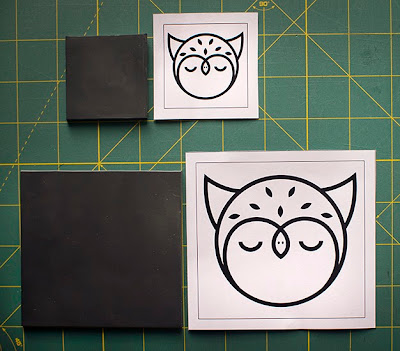 |
| Block A (top) Block B (bottom) |
Step 4: Go to a light table or a brightly lit window and with a pencil, mark off the corners of the border on the reverse side of the paper.
I like to do this so that when I'm ironing I know where the lino block and image are beneath the paper.
Step 5: Set up your ironing board or table, plug in your clothes iron and let it heat up to a low temperature setting. Mine was on "1- Acrylic". (*Of course, irons many vary in their temperature settings, so it is best to do a couple of small tests before working with the final lino block) We don't want it any hotter than that because I've found that hotter temperatures melt the ink too much and it become a bit blurry when being transferred. While the iron is taking a moment to heat up, we're going to line up our picture and linoleum piece.
Put your paper down on your ironing station - image side up and then place the lino block on top, lining it up with the handy border we printed. Then, holding the two pieces together carefully, we're going to flip them so that the lino block is at the bottom.
Double check that the border and the linocut block are still lining up. And if your iron has heated up, then we are ready to proceed to the next step.
Step 6: Very carefully start ironing over the paper. Use slow, smooth, short motions, and don't press down too hard. Like a gentle, slow-motion wiggling movement perhaps? Or a massage?
 |
| "Massage" the paper |
If you can, hold down one of the corners of the paper/linocut block duo to prevent the paper from slipping. After "massaging" the paper with the iron for about 30 seconds, your image should have transferred to the linoleum block.
Step 7: Remove the iron and carefully peel off the paper from the lino block.
 |
| Results from the Block B transfer |
And that's it! See, wasn't that speedy and easy? And much less messy than using transfer liquids or glues, carbon paper, or redrawing your image a bunch of times?
HOWEVER, if you peel your paper off and the image has smudged because you accidentally moved the paper as you were ironing, don't panic. There is an easy fix to this "oops".
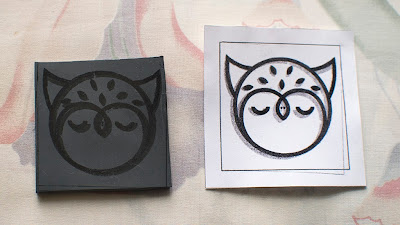 |
| Oh no, I made a mistake transferring Block A, but that's ok! |
*Take a paper towel, q-tip, or a cotton round and dab a little bit of nail polish remover on it. Apply it to the linoleum and wipe away the mistake.
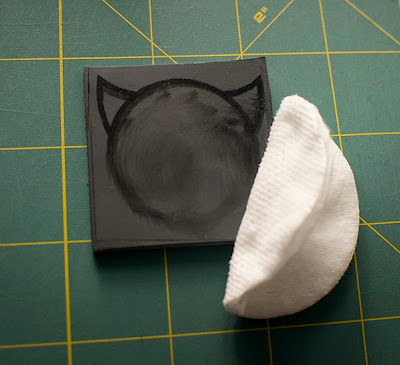 |
| Ink is starting to come off quickly, cleanup taking only a few seconds. |
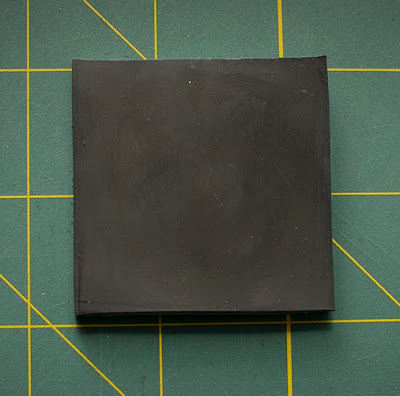 |
| All clean and ready to be used again! |
Here is my second attempt and it's a success!
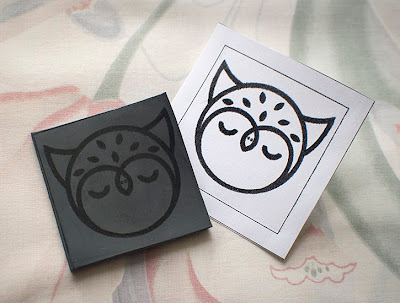 |
| If you've ironed on the border and that's a concern to you - take a q-tip dipped in nail polish remover and wipe away those parts only. |
Well, it's a success for the most part. If you've clicked to view the image larger you may have noticed the lines on this transfer aren't as crisp as on the first one I showed. This is because I heated my clothes iron to a higher temperature and "massaged" the paper for too long. It's nothing too terrible and I won't be going for a third attempt to transfer, but it's a good thing to keep in mind if you want to be super precise. Use the lowest heat setting and don't keep ironing for the fun of it. Just apply a firm but gentle hand, make sure you've gone over your entire image, and you're done.
The end!
I hope this was helpful! If you have any questions - feel free to ask. And if you'd like for me to do a tutorial based on some of techniques you may have spied in my work or previous posts, please don't hesitate to let me know and I'll do my best to make one. I'm considering making video tutorials in the future since I now have a pretty decent video setting on my new camera.
Cheers!
*All images in this post (especially the owl logo) are ©Mariya Olshevska.






Great tutorial! Thank you!
ReplyDeleteThank you so much for this! I had a hunch before searching that ironing might work. I'll be offering this tutorial as reference for my print students. Great step-by step info. Much appreciated.
ReplyDeleteMy pleasure! Thanks for stopping by :)
DeleteThanks for this tutorial. I'm excited to try this method!
ReplyDeleteNo problem! Hope everything goes well! =)
DeleteYou are awesome! I tried it today, and it worked perfectly!
ReplyDeleteThanks! Glad to hear it! :)
DeleteI tried it tonight and nothing printed. In fact I tried it four times to make sure but still not a single line. Some of the lines were quite fine but others were heavy. Any more suggestions. I used thin, charcoal linocut and went to a photocopy place to photocopy my drawing. The iron was on synthetic although it may be cooler so I moved it up for the last one. I tried 30 seconds, 40 seconds, 50 seconds and 60 seconds. nope.
ReplyDeleteI'm sorry to hear that! I'm not really sure what else you could try. Maybe it's the lino block that's somehow resisting the transfer, but I really don't know. My friends and I have tried this method out on a few different lino blocks and it's worked fine for us.
DeleteWere the black lines on the photocopy shiny (before you tried printing) ?
I've just tried this with 3.2 light grey hessian backed Lino and it didn't work very well. Every Iron is different, but I had to turn mine to about 50% to make any mark at all. Even then, the image was quite blurry.
ReplyDeleteHaving said that, I tried with the dark easy-carve rubbery lino which is for sale at craft stores/online. This worked much better, Lines were crisp and transferred on a lower temperature.
I would recommend inverting images which are primarily dark, as the more black you transfer the greater the likelihood that the detail will blur.
Thank you for sharing your experience! Much appreciated, especially your inclusion of the specific details!
DeleteWonderful! I am going to be coming back to your blog frequently!!! FINALY got a quicker method of transposing designs onto my future printing blocks!
ReplyDeleteFinally I found someone who provided a solution to my problem! Thank you!
ReplyDeleteThis seems easy. Can't wait to try it. Thanks !
ReplyDeleteWow this blog is wonderful i like reading your articles. Stay up thhe great work! You realize, lots of persons are looking around foor ths info, you could aid them greatly. linocut prints
ReplyDeleteThanks a ton...having been looking for a satisfactory approach...so nice and easy
ReplyDeleteWould this work for a two-tone reduction print? Like having one part be black and one part gray?-- would the gray transfer?
ReplyDeleteI haven't tried to do that before, so I can't be sure. Sorry!
DeletePlease let me know it you end up trying what the results are.
It worked!
DeleteGlad to hear it! :)
DeleteΦΩΤΟΑΝΤΙΓΡΑΦΙΚΑThis is my first time visit here. I found so many interesting stuff in your blog especially with important details.
ReplyDeleteHey i just followed your method and it doesn't work at all... I can barely get any ink transfered to the lino... What did i miss?
ReplyDeleteHi Alexandra,
DeleteDid the photocopy or printout of your image come from a xerox machine or using a laser printer? Otherwise the transfer won't work, or won't work as well.